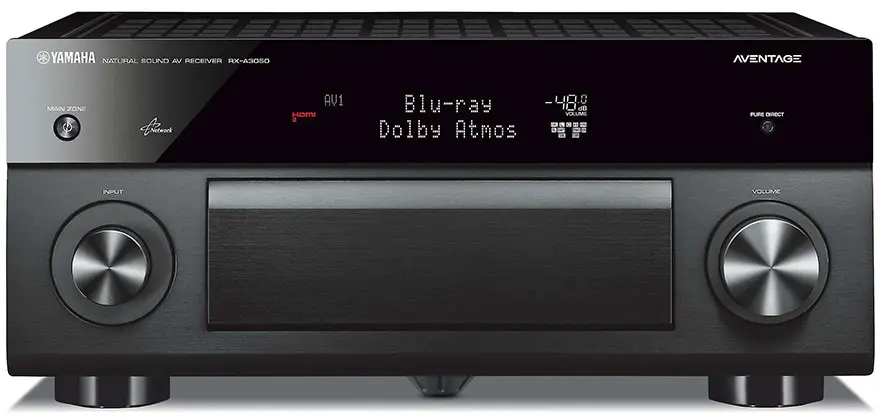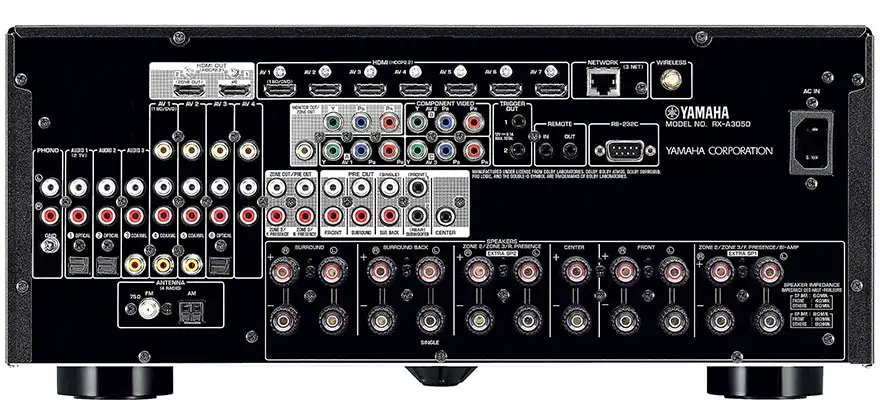It is pretty amazing that Yamaha launched the very first home cinema sound processor 30 years ago. Today, the company is known for so many things in the audio world. This includes the company’s AVENTAGE lineup which has been around for years and continues to refresh every year adding a common new feature set to every receiver in the lineup along with some exclusive stuff to the top tier model. On the very top of the AVENTAGE lineup is the CX-5100 although the price tag suggests pure audiophile territory. Those who demand virtually limitless flexibility without sacrificing the studio-quality sound have a somewhat cheaper option which happens to be the flagship model of the RX-A series – the Yamaha RX-A3050.
About the Yamaha RX-A3050
The Yamaha RX-A3050 is the home theater receiver made for the hardcore home theater system builders. It is a 9.2-channel receiver with 150 watts per channel and weighing a massive 40 pounds. That’s more than twice the weight of the entry level AVENTAGE RX-A550. Like other receivers in its class, the Yamaha RX-A3050 has an HDMI input on the front and 7 additional HDMI inputs on the back and all of them are ready for 4K technologies. It also features 2 HDMI outputs. It is currently priced at $2,199.95.
Below is the back panel layout. Click on image to enlarge for a clearer view.
Comparison with the Yamaha RX-3040
It is easy to dismiss the Yamaha RX-A3050 as a minor successor to the RX-3040 released the previous year because it looks the same, has some identical specs and possesses similar features like the aluminum front panel, Anti-Resonance Technology Wedge, symmetrical power amp layout and H-shaped Cross Member frame but there are plenty of improvements under the hood and a few extra features that the RX-A3040 can never obtain even through firmware updates.
The first major feature is a whole new wireless protocol that relies on the standard Wi-Fi connectivity. This feature is called MusicCast and it is represents Yamaha’s intention to compete against companies offering wireless multi-room audio solutions. So on its own, MusicCast is useless as it uses the Yamaha RX-A3050 as the bridge. But if you have a Yamaha speaker, soundbar or Hi-Fi system that also supports the MusicCast platform, you can essentially place that speaker anywhere in your home as long as it is within wireless range. Then the speaker essentially serves as its own zone where you can have it independently play back music. There is a dedicated MusicCast app for mobile devices so it is pretty easy to add wireless speakers to the receiver. Once added, you can do pretty interesting things remotely. On the basic side of things, you can have the main system play back one source while the speakers play back local music or tracks streamed from Spotify, Pandora and order online streaming services. But since the MusicCast links the receiver to the speaker, you can have other sources like Blu-ray or local TV programs stream to the speakers. So if you can muster up a few extra hundred dollar bills on proprietary Yamaha speakers, you will be rewarded with better versatility than competing multi-room audio platforms. If you want to cheapen out, you can also buy Bluetooth speakers as the Yamaha RX-A3050 has built-in Bluetooth and MusicCast supports streaming to Bluetooth speakers.
The Yamaha RX-A3040 supports Dolby Atmos once you upgrade the firmware. With the RX-A3050, Dolby Atmos is available right out of the box although it is still important to update the firmware as the recent update adds DTS:X support to the mix as well and you can only experience this technology on 2015 Yamaha receiver models or newer. DTS:X is a fantastic addition to Yamaha RX-A3050 because with Dolby Atmos-enabled receivers, you needed to buy special speakers to utilize the full benefits or buy and install ceiling speakers. Dolby Atmos remains as an option but if you have a typical 7.1-channel setup, you can keep your current set up and let DTS:X work its magic in providing a realistic 3-D surround sound experience. The cool thing is that Dolby Atmos speakers work with DTS:X too.
Another noteworthy feature is full compliance with the latest 4K standards complete with HDMI 2.0a compliance and HDCP 2.2 for all HDMI ports. This means that the receiver is ready to handle all types 4K content and take full advantage of the new High Dynamic Range feature which should improve the picture quality when a TV with that feature is hooked up. The user interface has been refreshed too along with a refined AV controller mobile app and an improved volume control unit.
Exclusive Features
If you have a 2-channel amp, you can expand the RX-A3050 from a 9.2-channel receiver to an 11.2-channel one. Utilizing all channels does limit your expansion to other rooms but MusicCast remains as a wireless option.
Also exclusive to the Yamaha RX-A3050 is a special variant of the CINEMA DSP technology known as CINEMA DSP HD3. It consists of four CINEMA DSP engines which harnesses advanced 3D processing to make 9.2-channel setups with dual front presence channels sound more realistic. Two different chipsets can be found in the receiver as well – the ES9016S SABRE32 Ultra DAC and the ES9006 SABRE Premier Audio DAC for true audiophile performance. Finally the RX-A3050 takes angle measurement into consideration when the YPAO speaker calibration feature is used.
Performance
The new jitter clock found exclusively in the latest AVENTAGE models including the Yamaha RX-A3050 really helps with the clarity of the sound. It is even noticeable when streaming music via Bluetooth and Wi-Fi. Compared to its predecessor, the improvements are minimal considering the similar specs but DTS:X can make a huge impact depending on your speaker configuration. HDR also provides a marginal improvement on the picture quality side of things.
Conclusion
Pros:
• MusicCast and 9.2-channel spec gives way to all sorts of multi-room possibilities.
• DTS:X support as a free firmware update.
• HDMI 2.0a and HDCP 2.2 support in tow.
• Minor performance improvements make its predecessor far less attractive.
Cons:
• MusicCast requires an extra investment.
• Some competing receivers have 3 HDMI outputs.
Verdict:
The Yamaha RX-A3050 is a killer flagship receiver because it didn’t just update the HDMI specification and minor things that some people may not care about; it also made some serious improvements and added new features to help it look more like a unique contender.
Update: There is a newer model > Yamaha RX-A3070


